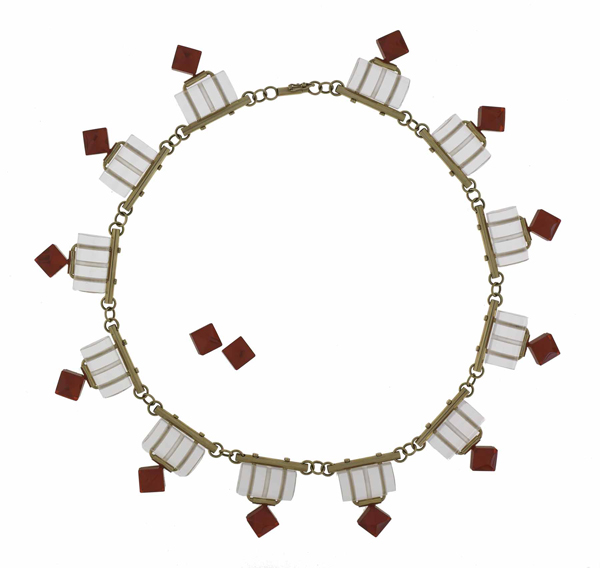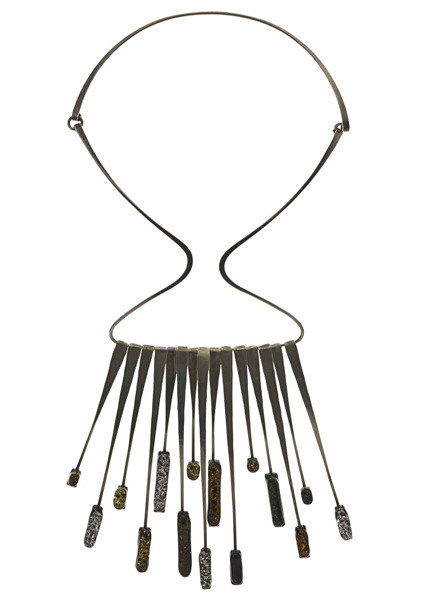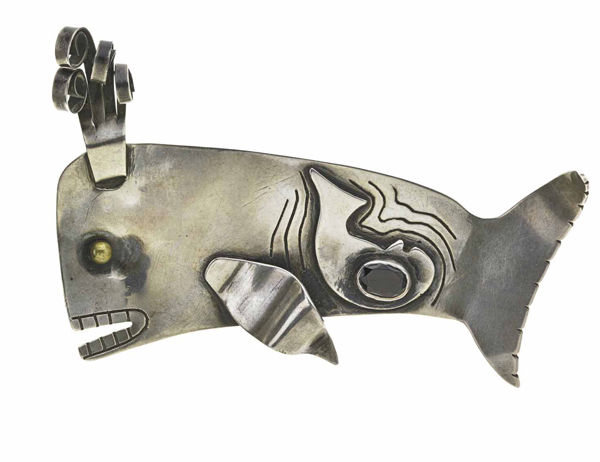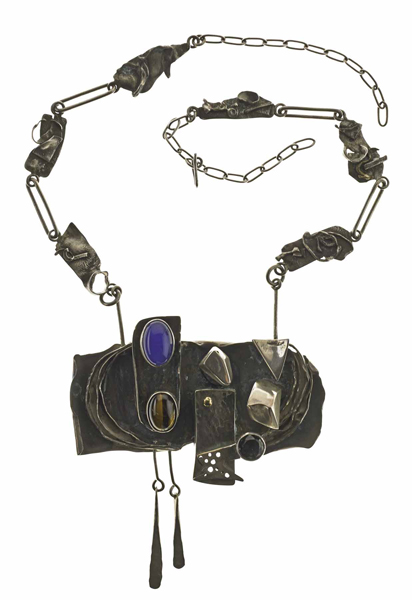
Susan Cummins: Please tell us something about Rago Auctions. Where are you located? Do you specialize in particular objects or artwork? How many auctions do you hold per year?
Suzanne Perrault: We are located in Lambertville, New Jersey, in a bucolic setting that’s snug between New York and Philadelphia, and have been at our present location since 1996. We began our business with auctions of 20th-century decorative arts and that remains a strong suit, but we sell and appraise a wide variety of property, from Asian to fine art to jewelry, as you can see from the listing on our website.
What makes Rago Auctions special or different from other auction houses?

How many people are on your team? Is there someone in particular on your staff who works with jewelry? Does that person have any background in handling mid-century or contemporary jewelry?
Suzanne Perrault: The entire staff is over forty people now, and Sarah Churgin leads the jewelry and silver department. Hailing from the People’s Republic of Brooklyn, Sarah has been collecting and dealing in silver and jewelry for more than 30 years. Her interest in craft jewelry harks back to jaunts to Woodstock and Rhinebeck in the 1970s, when she attended SUNY New Paltz. Katherine Van Dell is her second-in-command, and Robin Harris assists them both. Kim Sorensen and Sarah Dziamba catalogue 20th-century design and would handle most contemporary jewelry.
How do you work with people who want to auction something? What do you do and what do they do?

- We get dozens of auction estimate requests by e-mail daily. We try to respond to them within 24 to 48 hours, for free. If the owners wish to pursue selling with us and have property that is a good fit with our market, we write up a contract and e-mail it to them. They print it, sign it, and return it to us with the merchandise, which is dropped off, shipped, or picked up.
- We have free walk-in appraisals on most Mondays at the auction house in Lambertville. Anyone is welcome to bring up to six items to have them evaluated on the spot, at no cost, by our specialists. We get very fresh (new to market) property that way, and provide a good community service. Some people enjoy the camaraderie of Monday Walk-Ins, and prefer to get their estimates that way instead of the next option, which is…
- People can of course also contact us to meet with them for private evaluations.
Once the property is on hand at the auction house, it gets catalogued, photographed, and a listing is sent to the consignor with the descriptions as they will appear in the catalog, condition reports, and thumbnail photographs. Any adjustments of verbiage, finer points of display in photographs, or estimates/reserves are made at that point.
Once all the property is in and photographed (more or less), our specialist lots the items in a proper cadence for the catalog, which is part art and part science. The catalog is then laid out and designed, edited a million times, and then sent to the printer. The consignor receives a free copy of the catalog once it is printed, as do all the subscribers and clients. The online version of the catalog is made available on our website, as well as on several aggregator sites such as Bidsquare.
All the property is beautifully displayed for a weeklong preview at our Lambertville galleries, which culminates with the auction(s). The consignor checks go out 45 days after the sale.
I understand that you do appraisals, but since contemporary jewelry hasn’t come up at auction very much, how do you determine the value of a piece?
Suzanne Perrault: Like anything else, there’s a way to determine value when there are no comparables on the auction market. We can start with the gallery retail prices and go from there; we can ask collectors or dealers more familiar with esoteric artists to advise; we can also compare with items of a similar time, scale, material, and popularity to come up with a believable estimate. When all else fails, pricing conservatively is usually a good way to go.

Do you ever get objects, including jewelry, directly from artists or designers?
Suzanne Perrault: Sure. Artists, designers, and craftspeople often like to develop a secondary market, which gets their name published on art or aggregator sites.
What value do auction houses add to the market in general?
Suzanne Perrault: There are several ways:
- Auction houses likely bring significantly more eyeballs, international attention, and potential buyers to property than would occur with a gallery exhibit.
- Auctions provide competition, which firms up prices, giving them traction and accountability. All you need at auction are two people to compete and raise prices, making the works look even more desirable. Reputable auctions also provide transparency in pricing not readily available in other venues.
- When artists don’t have a presence on the secondary market, they might not appreciate the value of putting works at auction. The prices sometimes realized at first might appear to be a step backward. However, in the long run, the process might well turn out to be a move forward in helping artists receive the widespread recognition they deserve.

Suzanne Perrault: The Gen Xers and Millennials haven’t established their presence in the auction market quite yet, but they are quick to evidence their desire for self-expression through clothing, tattoos, and jewelry.
As modern dress is ever more casual, jewelry that is fussy or delicate can feel outmoded. Contemporary jewelry can be the architectural focal point of a low-key outfit. The new wave of body sculpture often consists of materials less precious than gold and diamonds, and spectacular statements are born of silver, wood, rubber, bone, composite, and glass (as well as plastic, pencils, paper, found objects, etc.). We have been seeing an increase of such contemporary statements in both our modern design and jewelry auctions, along with a growing following of buyers.
Bold new forms and materials are considerably more accepted now, at every pricing level, than they were a generation ago, with less reliance on the more predictable expressions of pearl strands or diamond solitaires. To wit, the recently opened gallery at The Metropolitan Museum of Art in New York that houses the Donna Schneier collection of contemporary jewelry (read AJF’s review) has certainly recontextualized where we stand vis-à-vis such an art form. Long gone are the days of Peggy Guggenheim and her coterie of artists at parties when only wealthy eccentrics and artists wore sculptural jewelry. Large-scaled, bold, and humorous pieces are now displayed in conservative circles, just as in more free-spirited ones.
Men also wear more jewelry besides wedding bands and Rolex watches. Speaking from personal experience, there is consistent sharing of a common jewelry pool in many households, where men and women wear crossover pieces such as expressive brooches, totemic necklaces, and a variety of bracelets. And earrings!
What can contemporary jewelry collectors and artists do to help the market grow in value?
Suzanne Perrault: A few ideas here, with some help from my Antiques Roadshow colleague Laura Woolley of the Collector’s Lab in Los Angeles:
- Appeal to young people by selling on eBay under “Fashion Jewelry” in order to get crossover appeal and learn who the artists are, who to look for
- Keep price point down to gain a wider pool of buyers
- Much in sales is about perception of cool and branding. You want to be the party people want to attend. Befriend stylists for celebrity placement. That should go a long way to promote the culture of cool.
How did you become interested in the world of auctions personally?
Suzanne Perrault: I wasn’t looking for the world of auctions, we just sort of found each other by chance. I worked in a gallery in New York in the 80s and met David Rago, who was holding Arts & Crafts Movement auctions a few blocks away, at the Puck Building. David helped divest the antiques in our gallery when my boss and friend Barton Kaplan passed away suddenly, much too young and full of promise. Scraping a living from the little bit that I knew, I eventually catalogued for David’s auctions, while busying myself at several New York galleries. I ended up moving to New Jersey to join the auctions full time. It’s been an interesting ride…
Thank you.




